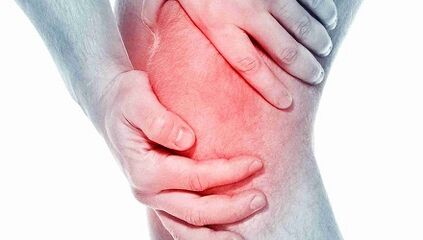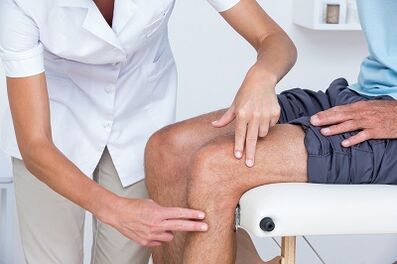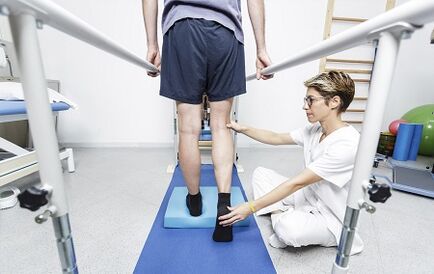The osteoarthritis of the knee joint is a chronic (long -term) degenerative disease that causes the destruction of cartilage in the joints.The symptoms include pain, stiffness and swelling.The treatment options for reducing pain and disabilities include lifestyle changes (nutrition, physical exercises), physical and professional treatment methods, medication and operations.
Osteoarthrosis of the knee joint
Osteoarthrosis of the knee joint is a common disease accompanied by chronic, strenuous pain.The latest clinical data showed that central sensitization stimulates the deforming osteoarthrosis of the knee joint.An improved understanding of how the osteoarthritis of the knee joints affects the central processing of pain is crucial for the identification of new analgesic goals/new therapeutic strategies.
Inhibitory receptors weaken the function of peripheral immune cells and modulate central neuroimmune answers.The systemic introduction of the receptor agonist weakened the OA-induced pain behavior and changes in circulating and anti-inflammatory cytokines.
Deformation arthrosis
The deforming osteoarthritis of the knee joint is inflammation and wear of the cartilage on the bones that form the knee joint (osteo = bones, artro = joint, itis = inflammation).The diagnosis of osteoarthritis of the knee joint is based on two main results: radiological data on changes in bone health (using medical images such as X-ray and magnetic resonance image of the MRI) and human symptoms.Around 14 million people have symptomatic knee arthrosis.Although more often in the elderly, 2 million out of 14 million people with a symptomatic OA of the knee were younger than 45 years old during the diagnosis, and more than half were younger than 65.
Osteoarthritis (OA knee) is a progressive disease caused by inflammation and degeneration of the knee joint, which deteriorates over time.
This affects the entire joint, including bones, cartilage, ribbons and muscles.Its development is influenced by age, body mass index (BMI), bone structure, genetics, muscle strength and activity level.The OA knee can also develop as a secondary condition after the knee injury.Depending on the stage of the disease and the presence of injuries or illnesses associated with it, the OA knee can be checked using physiotherapy.Surgical intervention may require heavier or expanded cases.
Symptoms
People who develop the knee -oa can experience a wide range of symptoms and restrictions based on the development of the disease.The pain occurs when the cartilage that covers the bones of the knee joint.The areas in which the cartilage has been used or damaged exposes the underlying bone.The effect of the bone enables you to increase the stress and compression of the cartilage and sometimes bone contact when moving, which can cause pain.Since the knee is a joint, the level of activity, the activity level and the type and duration of the actions generally affect the symptoms.For example, the symptoms can deteriorate in weight activity if they go with a heavy object.

The symptoms of the knee joint can include:
- Determination of pain during or after the operation, especially when walking, climbing, go through the stairs or from a session to a standing position.
- Pain or stiffness after sitting with a curved or straight knee for a long period of time.Pain is the most common symptom of osteoarthritis.If the disease develops and inflamed, pain can become constant.
- A feeling of jumping out, cracks or grinding when you move your knee.
- Swelling after action.
- The stiffness of the affected connection was often seen first in the morning and after calm.
- Edema that is sometimes warm can be felt in the joint with arthritis.
- Deformation can occur in osteoarthritis due to bone growth and cartilage loss.The growth of bones in the end compounds of the fingers is referred to as Hyberden nodes.BUSHAR nodes are the growth of bones in the center connections of the fingers.The degeneration of the cartilage of the knee joint can lead to the outer curvature of the knees (onions).
- A cracking noise or a grate feeling can be noticed if arthritis moves.This is caused by wiping the bone against bones or rough cartilage.
Usually these symptoms do not occur suddenly and at once, but gradually develop over time.Sometimes people do not admit that they have osteoarthritis because they cannot remember a certain time or a certain injury that caused their symptoms.If the knee pain has deteriorated for several months, which does not react to calm or changes in activity, it is better to advise a medical worker.
Diagnosis
Osteoarthritis can often be diagnosed by its characteristic symptoms of pain, reduced movement and/or deformation.Osteoarthritis can be confirmed by X-ray or MRI scanning.The general data includes the narrowing of the joint space between the bones, the loss of cartilage and bone spores or the growth of bones.Blood tests can be used to exclude other possible diseases, but they cannot diagnose osteoarthritis.

2 primary process is diagnosed in the knee -oa.The first is based on a report on the symptoms and the clinical examination.The physiotherapist will ask questions about medical history and activity.The therapist will carry out a physical examination to measure the movement of the knee (area of movement), strength, mobility and flexibility.You can also ask different movements to see, increase or reduce the pain.
The second tool for diagnosing the knee joint is a diagnostic visualization.The physiotherapist can send to the doctor who prescribe the x rays of the knee in different positions to check damage to the bone and cartilage of the knee joint.
If the connections of serious damage to the joints become, you can order an MRI to examine the overall status of joint and surrounding fabrics more precisely.
Blood tests can also be arranged to exclude other diseases that can cause symptoms that are similar to the osteoarthritis of the knee joints.
Treatment
Depending on the severity of arthritis and the age of the patient, it is selected how the osteoarthritis of the knee joints is treated.Treatment can consist of operational or conservative methods or your combinations.
The first treatment line of arthritis of the knee joint includes modification of activity, anti -inflammatory medication and weight loss.
The rejection of actions that improve pain can make this condition acceptable for some people.Anti -inflammatory drugs help to alleviate inflammation that can contribute to pain.
Physiotherapy to strengthen the muscles around the knee can help absorb part of the shock given to the joint.This applies in particular to arthritis with a knee switch (patello femoral).Special types of braces that transfer the load into the part of the knee joint, which is less than arthritis, can also relieve pain.Injections of drugs in the knee joint can also help temporarily.
In addition, walking with a stick in the hand on the opposite side reduces, since a painful knee can help distribute part of the load, pain.Finally, weight loss helps to reduce the power that leads through the knee joint.The combination of these conservative measures can help relieve pain and prevent disabilities.
If these methods do not allow you to make the condition tolerant, the operation may be the best option to treat arthritis of the knee joint.The exact type of operation depends on age, anatomy and the main condition.Some examples of surgical options for the treatment of arthritis are osteotomy that is to cut the bone to align the joint.
The modern methods for the treatment of osteoarthritis of the knee joint include osteotomy, which is a good alternative when the patient is young and arthritis is limited by an area of the knee joint.This enables the surgeon to rebuild the knee in order to unload the arthritis area and relatively impossible to carry out the load in the participation of parts of the knee joint.For example, the patient can be rebuilt to distribute the load through the joint.The advantage of this type of operation is that the patient's knee joint is preserved and may be able to ensure many years of pain relief without the shortcomings of the knee prosthesis.The disadvantages include a longer rehabilitation course and the opportunity to develop arthritis in a recently founded knee.
The operation to replace the knee joint includes the cutting of the arthritic bone and the introduction of the prosthesis connection.All arthritic surfaces are replaced, including femoral, lower leg and knee switches.Arthritic surfaces are removed and the ends of the bone are replaced by a prosthesis.The prosthesis component is usually made of metal and plastic surfaces that are designed against each other for a smooth gliding.
Replacing the knee joint
The overall surgery to replace the knee joint was first carried out in 1968 and developed over the years on a reliable and effective method to remove pain when switching off and enable the patient to resume their active life.Improvements in the field of surgical methods and implants have contributed to the fact that this has been designed to be one of the most successful orthopedic procedures today.If the population gets older and remains more active, the need for a general exchange of the knee continues to grow.Many of the operations that replace the knee joint took place in the hospital for special operations.Improvements in surgical technology and the design of new implants are some of the contributions that surgeons have made.
People often wonder when and why they should replace their knees.This is an individual question that depends on the level of human activity and functional needs.Many people with osteoarthritis live with pain, which prevents them from participating in activities.Others are so weak that it is difficult for them to wear shoes and socks.A complete exchange of the knee joint offers the solution to the problem of osteoarthritis and is carried out to relieve pain and resume activity.After rehabilitation from the successful complete replacement of the knee joint, the patient can expect surgery without pain.A complete exchange of the knee joint improves the patient's condition significantly and significantly reduces the long -term treatment costs.This study showed that not only the general replacement of the knee joint is economically effective, but also offers greater functionality and the best quality of life.
A complete exchange of the knee joint is seen as the main process, and the solution is not trivial.Usually people decide to undergo surgery if they feel that they no longer live with their arthritis.
The implant consists of 4 parts: tibia, thigh parts, plastic insert and a pattern.The components of the tibia and femur are made of metal, usually cobalt chrome, to close the ends of the thigh and the lower leg after they have removed the arthritic bone.The plastic insert consists of polyethylene from Ultra -Higher Molecular Arm mass and fits into the Tibia component, so that the polished thigh surface slides along the plastic.The component of the knee chaste also glides against the front of the thigh component.They are usually attached to the bone cement.
The fully replacement of the knee takes place in the operating room with a special laminar air flow system with which the likelihood of infection is reduced.Her surgeon bears a "spaceplay" that also reduces the likelihood of infection.The entire surgical team consists of their surgeon, of two to three assistants and nannies.
Anesthesia takes place by an epidural catheter that is a small tube in the back.During the operation, the patient can be both awake and sleepy.
After the introduction of the epidural block around your thigh, a tournament or a cuff is placed.The horizontal rod is overrated during the operation to reduce blood loss.The excerpt for the completely replacement of the knee is done along the front knee.Depending on the anatomy, the incision is measured from 4 to 10 inches.
Arthritic surfaces of the femur, the lower leg and the patella are exposed and removed using power tools.At the same time, the deformations of the knee are corrected, and after the operation the knee is getting straight.The bone is ready to take an artificial knee joint, and then a prosthesis is inserted.During the closure, two drainage is installed in the work area to help with the evacuation of blood.Sapers are used to close the skin.

The entire operation takes 1 to 2 hours.Then the patient is brought to the recreation room in which the tests are checked.Most patients can be brought to a normal room for several hours.Others have to stay in the hall to recover, as defined by a surgeon and an anesthetist.
The patients usually stay in the hospital for 3-4 days after a complete operation to replace the knee
Risks during the operation
Some of the risks of the surgical intervention include blood loss, the formation of a clot and the likelihood of infection.The general prevalence of these risks is very small.They should be discussed with the surgeon before the operation begins.
Some of the risks for the presence of a knee prosthesis are the probability that parts can be weakened or worn over time, or the prosthesis can be infected.These topics are also discussed with the surgeon.
Postoperative course
Immediately after a complete operation to replace the knee joint, the patient falls into the recreation room.Most patients can get to a regular ward after a few hours if the feeling returns to their legs.A pain pump connected to an epidural catheter is given, which enables them to control if a healing for pain is given.
On the day of the operation, you can carry out some exercises on how the physiotherapist shows, including reducing the quadriceps and moving the legs up and down.Depending on the surgeon's preference, you can begin to bend your new knee immediately after the operation or on the first day.The patient may take ice after the operation to wet his mouth, but drink liquids or they can cause nausea.The patient has a catheter in the bladder, so they don't have to worry about urination.As soon as the movement in the legs is restored, it can sit down, get up and take a few steps with a hiker and therapist.
On the first day after the operation, it becomes active and developed to become more mobile.
The patient will meet with physiotherapists who teach additional exercises.They also help you get on your feet and take a few steps with a walk.As a rule, the patient can drink pure liquid.
It will be easier and easier to move in the next few days.The patient is released from pain and urea catheters.The treatment of pain is given in the form of tablets.On the second day after the operation, it can be found in the intestine signs of recovery, ordinary food can eat.
Depending on their age, preoperative physical condition and the insurance coating, the patient can be a candidate for short -term accommodation in a rehabilitation facility.Otherwise the patient will be released home and the physiotherapist comes to his house to continue rehabilitation.The dispatcher will discuss these options with the patient and help him plan his return home.
A return to activity is led by a surgeon and therapist.As a rule, patients can go as much as they want 6 weeks after the operation.Patients can resume movement after 6 weeks.After 8 weeks, patients can play the game in the golf and swimming again.You can play tennis at 12 weeks.The surgeon helps to decide which measures can be taken up again.
What the physiotherapist is needed

All physiotherapists are created by education and clinical experience to treat various diseases or injuries:
- A physiotherapist who has experience in the treatment of people with osteoarthritis of the knee joint and replaces the knee joint after the operation.Some physiotherapists have a practice with an orthopedic focus.
- A physiotherapist who is a certified orthopedic clinical specialist.This physiotherapist has advanced knowledge, experience and skills that can be applied to a state.
- You will find physiotherapists who have these and other accounting data with an MRI, an online tool with which physiotherapists can be found with specific clinical knowledge.
General advice if you find a physiotherapist (or another provider of medical services):
- Recommendations of family and friends or from other providers of medical services;
- If you contact physiotherapy for admission to the clinic, you have to ask about the experience of physiotherapists to support people with arthritis.
During the first visit with the physiotherapist, you must be willing to describe the symptoms as more detailed and report on activities that make the condition worse.





















